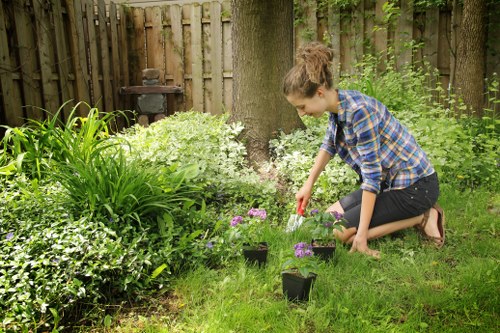Hedge Trimming in Stockwell: Achieving Pristine Garden Hedges

Hedge trimming is a fundamental aspect of garden maintenance in Stockwell, ensuring that your outdoor spaces remain beautiful and well-kept throughout the year. Whether you're a seasoned gardener or a homeowner taking the first steps in landscaping, understanding the nuances of hedge trimming can make a significant difference in the appearance and health of your garden.
Properly trimmed hedges not only enhance the aesthetic appeal of your property but also promote the health and longevity of the plants. Regular maintenance prevents overgrowth, reduces the risk of disease, and encourages dense, vibrant foliage.
In this comprehensive guide, we'll explore everything you need to know about hedge trimming in Stockwell, from the benefits and techniques to the best tools and seasonal considerations. By the end of this article, you'll be equipped with the knowledge to maintain your hedges effectively, ensuring they remain a focal point of your garden.
The Importance of Hedge Trimming

Maintaining your hedges through regular trimming is crucial for several reasons. Firstly, it helps to shape the hedges, ensuring they complement the overall design of your garden. A well-shaped hedge can serve as a living fence, providing privacy and defining different areas within your outdoor space.
Secondly, trimming promotes healthy growth. By removing dead or diseased branches, you prevent the spread of pests and infections, ensuring that your hedges remain robust and lush. Additionally, trimming encourages the growth of new shoots, resulting in a fuller and more attractive appearance.
Lastly, regular maintenance makes future trimming easier and less time-consuming. By keeping up with the task periodically, you avoid the need for drastic and labor-intensive pruning sessions later on.
Benefits of Regular Hedge Maintenance

Consistent hedge maintenance offers numerous advantages for your garden:
- Aesthetic Appeal: Well-maintained hedges add structure and beauty to your landscape.
- Healthier Plants: Regular trimming removes diseased or damaged parts, promoting healthier growth.
- Enhanced Privacy: Denser hedges provide better screening from neighbors and passersby.
- Increased Property Value: A well-kept garden can enhance the overall value of your property.
- Environmental Benefits: Healthy hedges contribute to better air quality and provide habitats for wildlife.
By investing time and effort into hedge trimming, you're ensuring that your garden remains a vibrant and inviting space throughout the year.
Types of Hedges Commonly Trimmed in Stockwell

Stockwell's climate and soil conditions are suitable for a variety of hedge types. Some of the most popular hedges include:
- Boxwood: Known for its dense foliage and versatility, boxwood is a favorite for formal gardens. Its ability to withstand heavy pruning makes it ideal for creating intricate shapes and designs.
- Privet: Fast-growing and easy to shape, privet is ideal for creating privacy screens. It's resilient and can handle frequent trimming without losing its vigor.
- Laurel: With its large leaves and thick growth, laurel hedges provide excellent coverage. They are evergreen, offering year-round privacy and greenery.
- Holly: Evergreen and thorny, holly hedges offer both beauty and security. They're excellent for deterring unwanted guests while adding a festive appearance to your garden.
- Yew: Yew hedges are long-lived and can tolerate heavy pruning. They are perfect for creating formal boundaries and adding a classic touch to your landscape.
Choosing the right type of hedge depends on your specific needs, aesthetic preferences, and the level of maintenance you're willing to undertake. Each type has its unique characteristics, so it's essential to consider these factors before making a decision.
Evergreen vs. Deciduous Hedges

Evergreen hedges retain their leaves throughout the year, providing constant privacy and greenery. They are generally more resistant to pests and diseases, making them a practical choice for many homeowners. Evergreens like boxwood and laurel are excellent for maintaining a uniform appearance, especially in areas prone to harsh weather conditions.
On the other hand, deciduous hedges shed their leaves seasonally, which can be beneficial for allowing sunlight to reach lower areas of your garden during winter months. While they may require more maintenance to manage leaf fall, deciduous hedges can add seasonal variety and interest to your landscape. Plants like hornbeam and beech fall into this category, offering vibrant colors in autumn and a clean look during winter.
Both types have their own unique advantages, and the choice ultimately depends on your garden's specific requirements and your personal preferences. Incorporating a mix of evergreen and deciduous hedges can provide year-round interest and functionality.
Essential Tools for Hedge Trimming

Having the right tools is essential for effective hedge trimming. Some of the must-have equipment includes:
- Pruning Shears: Ideal for precision trimming and shaping smaller hedges. They allow for clean cuts, which are important for the health of the plant.
- Hedge Trimmers: Electric or gas-powered trimmers are suitable for larger hedges, providing efficiency and ease of use. They can quickly trim large areas, saving time and effort.
- Loppers: Useful for cutting thicker branches that pruning shears can't handle. Loppers provide the necessary leverage to make clean cuts on heavy growth.
- Protective Gear: Safety glasses, gloves, and ear protection are important to ensure safety during trimming. Protective clothing can prevent injuries from sharp tools and debris.
- Rubbish Saw: For cutting and removing larger branches, a rubbish saw is a valuable tool to have on hand.
Investing in quality tools not only makes the job easier but also ensures cleaner cuts, which can promote healthier hedge growth. Regular maintenance of these tools, such as sharpening blades and cleaning, will extend their lifespan and effectiveness.
Hedge Trimming Techniques

Proper trimming techniques are critical for maintaining the health and appearance of your hedges. Here are some key methods:
- Shearing: This method involves cutting the hedge to create a uniform and defined shape, typically used for formal hedges. Shearing ensures straight lines and an even appearance, making it ideal for structured garden designs.
- Selective Pruning: Removing specific branches or sections to promote natural growth and maintain the hedge's health. This technique helps in controlling the shape while allowing the plant to grow naturally.
- Thinning: Reducing the density of the hedge to allow light and air to penetrate, which helps prevent disease. Thinning is especially important for older hedges that have become too dense.
- Heading Cuts: Cutting back the ends of branches to encourage bushier growth. This technique is useful for shaping and controlling the size of the hedge.
- Pinching: Removing the tips of new growth with your fingers or small tools to encourage branching. Pinching is effective for young hedges to establish a desired shape.
Choosing the right technique depends on the type of hedge and the desired outcome. Consistent application of these methods will result in a well-maintained and attractive garden feature.
Timing Your Hedge Trimming

The timing of your hedge trimming is just as important as the technique. In Stockwell, the best times to trim hedges are:
- Late Spring: Ideal for promoting new growth and shaping hedges after the active growing season. Trimming in late spring allows plants to recover quickly and develop a robust structure.
- Late Summer: Useful for maintaining shape and controlling growth as the season progresses. This timing helps manage the hedge's size before the onset of fall.
- Early Autumn: Helps to tidy up before winter, but avoid trimming after mid-autumn to prevent new growth susceptible to frost. Early autumn trimming ensures that the hedge remains tidy without encouraging new growth that could be damaged by cold weather.
- Mid-Winter: Generally, it's best to avoid trimming hedges in mid-winter, as plants are dormant and less responsive to pruning. However, light trimming may be possible if necessary.
Avoid trimming hedges in late autumn or winter, as this can damage the plants and make them more vulnerable to diseases. Understanding the seasonal growth patterns of your hedges will help you determine the optimal times for trimming.
DIY vs. Professional Hedge Trimming

When it comes to hedge trimming in Stockwell, you have the option to either undertake the task yourself or hire a professional service. Both approaches have their pros and cons:
- DIY Trimming: Cost-effective and allows for personal customization, but it requires time, effort, and the right tools. DIY trimming can be satisfying and gives you complete control over the process, but it may be challenging for larger or more complex hedges.
- Professional Services: Offer expertise, efficiency, and high-quality results, though at a higher cost. Professionals have the experience and equipment to handle all sizes and types of hedges, ensuring precise and safe trimming.
- Hybrid Approach: Some homeowners choose to perform basic trimming themselves and hire professionals for more detailed or difficult tasks. This approach can balance cost savings with achieving professional-quality results where needed.
Consider factors such as the size and type of your hedges, your budget, and the level of precision you desire when deciding which option is best for you. Assessing your own capabilities and the demands of the task will help you make an informed decision.
Choosing the Right Professional

If you decide to hire a professional hedge trimming service in Stockwell, it's important to choose a reputable and experienced provider. Here are some tips:
- Check Reviews: Look for customer feedback and testimonials to gauge the quality of the service. Platforms like Google Reviews or local gardening forums can provide insights into a company's reputation.
- Verify Credentials: Ensure the company is licensed, insured, and employs trained professionals. Proper credentials indicate reliability and commitment to quality workmanship.
- Request Quotes: Compare prices and services offered to find the best value for your needs. Detailed quotes help you understand what is included and avoid hidden costs.
- Ask About Their Process: Understanding how they approach hedge trimming can help you set expectations. Inquire about the techniques they use and their maintenance schedule recommendations.
- Check for Guarantees: Reliable companies often offer guarantees or warranties for their work, providing peace of mind and assurance of quality.
Choosing the right professional ensures that your hedges are trimmed correctly and safely, leading to long-lasting results. Taking the time to research and select a reputable service will pay off in the quality of your garden's upkeep.
Seasonal Considerations for Hedge Trimming

Different seasons present unique challenges and opportunities for hedge trimming. Here are some considerations for each season:
- Spring: As plants emerge from dormancy, spring is an excellent time for hedge trimming. It allows you to shape your hedges before the growing season begins, promoting healthy and vigorous growth.
- Summer: During the peak growing season, hedge trimming helps control rapid growth, preventing hedges from becoming overgrown. Regular maintenance in summer ensures your hedges remain tidy and manageable.
- Autumn: Trimming in early autumn can help prepare your hedges for the winter months. It's a good time to remove any dead or weak branches and reduce the hedge's overall size.
- Winter: Generally, it's best to avoid trimming hedges in winter, as plants are dormant and less responsive to pruning. However, if necessary, light trimming can be performed to remove any obvious damage caused by winter weather.
Adapting your hedge trimming practices to the seasons helps ensure healthier plants and better-looking hedges throughout the year. Understanding the growth patterns and requirements of your specific hedge types will guide your seasonal maintenance efforts.
Common Mistakes to Avoid in Hedge Trimming

Avoiding common mistakes can greatly improve the results of your hedge trimming efforts. Here are some pitfalls to watch out for:
- Over-Trimming: Cutting back too much of the hedge can stress the plants and hinder their growth. It's essential to trim gradually and avoid removing more than one-third of the hedge's volume at a time.
- Wrong Timing: Pruning at the wrong time of year can damage the hedges and make them vulnerable to diseases. Always consider the seasonal growth patterns before scheduling your trimming sessions.
- Poor Technique: Inadequate cutting methods can lead to uneven growth and weak structures. Using proper techniques ensures clean cuts and promotes healthy regrowth.
- Using Dull Tools: Dull or improper tools can cause ragged cuts, increasing the risk of infections. Always maintain your tools by sharpening blades and replacing worn parts as needed.
- Ignoring Plant Health: Trimming sick or damaged hedges without addressing underlying issues can exacerbate problems. Ensure that your hedges are healthy before performing heavy trimming.
By being mindful of these mistakes, you can ensure that your hedge trimming is effective and beneficial for your plants. Proper planning and execution are key to maintaining beautiful and healthy hedges.
Maintaining Healthy Hedges

Healthy hedges require more than just regular trimming. Consider the following tips to keep your hedges in top condition:
- Proper Watering: Ensure your hedges receive adequate water, especially during dry periods. Deep watering encourages strong root growth and resilience against drought.
- Fertilization: Use appropriate fertilizers to provide essential nutrients for growth. Organic fertilizers can improve soil health and promote vibrant foliage.
- Pest Control: Monitor for pests and treat any infestations promptly to prevent damage. Integrated pest management strategies can help maintain a balanced ecosystem in your garden.
- Regular Inspection: Check your hedges periodically for signs of disease or stress. Early detection of issues allows for timely intervention and prevents major problems from developing.
- Soil Health: Maintain healthy soil by adding compost or mulch. Good soil structure supports robust hedge growth and overall plant health.
Taking a holistic approach to hedge care will complement your trimming efforts, resulting in vibrant and resilient plants. Healthy hedges are better equipped to withstand environmental stresses and provide lasting beauty to your garden.
Choosing the Right Time for Hedge Trimming

Selecting the optimal time to trim your hedges can impact their health and growth. Generally, it's best to trim:
- After the flowers have bloomed to avoid cutting off budding buds. Trimming post-bloom ensures that ornamental hedges maintain their flowering potential.
- During periods of active growth to allow for quick healing of cuts. Trimming during the growing season promotes rapid recovery and vigorous new growth.
- Avoiding extreme weather conditions such as intense heat or frost. Trimming in mild weather reduces the risk of plant stress and damage.
- Before the onset of rainy seasons to prevent moisture-related diseases from developing in newly cut areas.
By timing your hedge trimming appropriately, you can promote better growth patterns and maintain the desired shape and size of your hedges. Understanding the specific needs of your hedge types will further enhance the effectiveness of your trimming efforts.
Post-Trimming Care

After completing your hedge trimming, proper care is essential to ensure recovery and continued growth:
- Clean Up: Remove all trimmings and debris to prevent pests and diseases. Clearing the area around your hedges helps maintain a clean and healthy garden environment.
- Inspect: Check for any missed areas or uneven cuts and make adjustments as needed. Ensuring uniformity in your trimming enhances the overall appearance of your hedges.
- Apply Mulch: Adding mulch around the base can help retain moisture and suppress weeds. Mulching also improves soil structure and provides a protective barrier against temperature fluctuations.
- Watering: Provide adequate water to help the plants recover from the stress of trimming. Consistent watering supports new growth and strengthens the plant's root system.
- Fertilization: Consider applying a balanced fertilizer to replenish nutrients lost during trimming. This promotes healthy regrowth and maintains the vitality of your hedges.
These post-trimming steps help maintain the health and appearance of your hedges, ensuring they continue to flourish. Regular care after trimming reinforces the benefits of your maintenance efforts.
Environmental Benefits of Well-Trimmed Hedges

Well-trimmed hedges offer several environmental benefits, making them a valuable addition to any garden:
- Air Quality: Hedges act as natural air filters, trapping pollutants and producing oxygen. They help improve the overall air quality around your home.
- Wildlife Habitat: They provide shelter and food for various birds and beneficial insects. Hedges contribute to biodiversity by supporting a variety of species.
- Microclimate Regulation: Hedges can help moderate temperature extremes, providing shade during hot months and acting as windbreaks in colder seasons.
- Soil Erosion Control: Their root systems stabilize the soil, preventing erosion and nutrient runoff. This is particularly important in areas prone to heavy rains or wind.
- Noise Reduction: Dense hedges can absorb and block noise pollution, creating a quieter and more peaceful garden environment.
By maintaining your hedges, you're contributing to a healthier environment both on a small scale in your garden and more broadly in your community.
Enhancing Curb Appeal with Trimming

First impressions matter, and well-trimmed hedges can significantly enhance the curb appeal of your home. Here's how:
- Symmetry and Balance: Evenly trimmed hedges create a sense of order and balance in your garden design. Symmetrical hedges are pleasing to the eye and reflect a well-maintained property.
- Defined Boundaries: They clearly mark property lines and garden beds, adding structure to your landscape. Defined boundaries help organize your garden space and prevent encroachment into unwanted areas.
- Seasonal Color: Highlighting the natural colors of your hedges through trimming can boost the visual interest of your garden. Some hedges bloom with colorful flowers or retain vibrant foliage, adding seasonal appeal.
- Inviting Spaces: A tidy and well-maintained garden is more inviting for visitors and passersby. It reflects the care and attention you put into your outdoor space.
Investing time in hedge trimming can pay off by making your property more attractive and desirable. A beautiful garden not only enhances your living experience but also adds value to your home.
Tips for Effective Hedge Trimming

To achieve the best results when trimming hedges in Stockwell, consider the following tips:
- Plan Ahead: Determine the shape and size you want your hedges to be before you start trimming. Sketching a rough outline can help guide your pruning efforts and ensure symmetry.
- Use Sharp Tools: Clean, sharp tools make precise cuts and reduce the risk of damaging the plants. Dull blades can crush the stems, making it easier for diseases to take hold.
- Trim Gradually: Instead of removing large amounts at once, trim in stages to avoid stressing the hedges. Gradual trimming encourages healthy regrowth without shocking the plant.
- Maintain Regularly: Regular maintenance prevents overgrowth and keeps your hedges looking their best. Establishing a consistent trimming schedule makes the task more manageable.
- Be Consistent: Keep a consistent trimming schedule to ensure even growth and a uniform appearance. Consistency helps in maintaining the overall shape and health of your hedges.
- Avoid Cutting into the Old Wood: Cutting into older, unproductive wood can stunt the growth of your hedges. Focus on trimming newer growth to encourage a healthier and denser structure.
Implementing these practices will help you maintain healthy, attractive hedges with minimal effort. Attention to detail and consistency are key to successful hedge trimming.
Eco-Friendly Trimming Practices

Adopting eco-friendly trimming practices can benefit both your garden and the environment:
- Use Organic Mulch: Compost or natural mulch enriches the soil and supports healthy plant growth. It also helps retain moisture and suppresses weed growth.
- Recycling Trimmings: Use hedge clippings as mulch or compost them to reduce waste. Recycling organic material contributes to a sustainable gardening practice.
- Energy-Efficient Tools: Opt for electric or manual tools over gas-powered ones to minimize emissions. Energy-efficient tools are not only better for the environment but also quieter and often require less maintenance.
- Water Conservation: Implement efficient watering systems to support your trimmed hedges without wasting water. Drip irrigation or soaker hoses can provide targeted watering, reducing water usage.
- Natural Pest Control: Utilize natural predators or organic treatments to manage pests. Avoiding chemical pesticides protects beneficial insects and maintains a balanced ecosystem.
These sustainable approaches not only help the planet but also promote a healthier garden ecosystem. Eco-friendly practices ensure that your hedge trimming efforts contribute positively to the environment.
Conclusion: Maintaining Beautiful Hedges in Stockwell

Hedge trimming in Stockwell is an essential practice for anyone looking to enhance their garden's beauty and health. Regular maintenance, the right tools, proper techniques, and timely care all contribute to lush, vibrant, and well-shaped hedges.
Whether you choose to take on the task yourself or hire a professional service, the benefits of well-trimmed hedges are undeniable. From improved aesthetics and increased property value to environmental advantages, investing in hedge trimming is a decision that will pay off for years to come.
Don't wait any longer to achieve the perfect hedges for your garden. Contact us today to schedule your hedge trimming service or book your service now and take the first step towards a more beautiful and healthy garden.

